Managing Accounting and Control: Transfer Pricing Methods Analysis
VerifiedAdded on 2020/07/23
|12
|4057
|42
Report
AI Summary
This report delves into the critical examination of transfer pricing methods within the realm of financial management and accounting control. The introduction highlights the importance of transfer pricing in globalized business operations, particularly for multinational companies engaging in cross-border transactions. The report then explores various transfer pricing methods, including market-based, full-cost, cost-plus mark-up, and negotiated transfer pricing. Each method is analyzed with its advantages, disadvantages, and practical applications. The report also discusses the role of Strategic Management Accountants (SMA) in utilizing managerial accounting information for forward-looking objectives, such as making shut or keep, pricing, product mix, and make or buy decisions. The report further examines the implications of these decisions on financial performance and strategic alignment. The analysis includes references to relevant literature and frameworks to support the findings and recommendations.
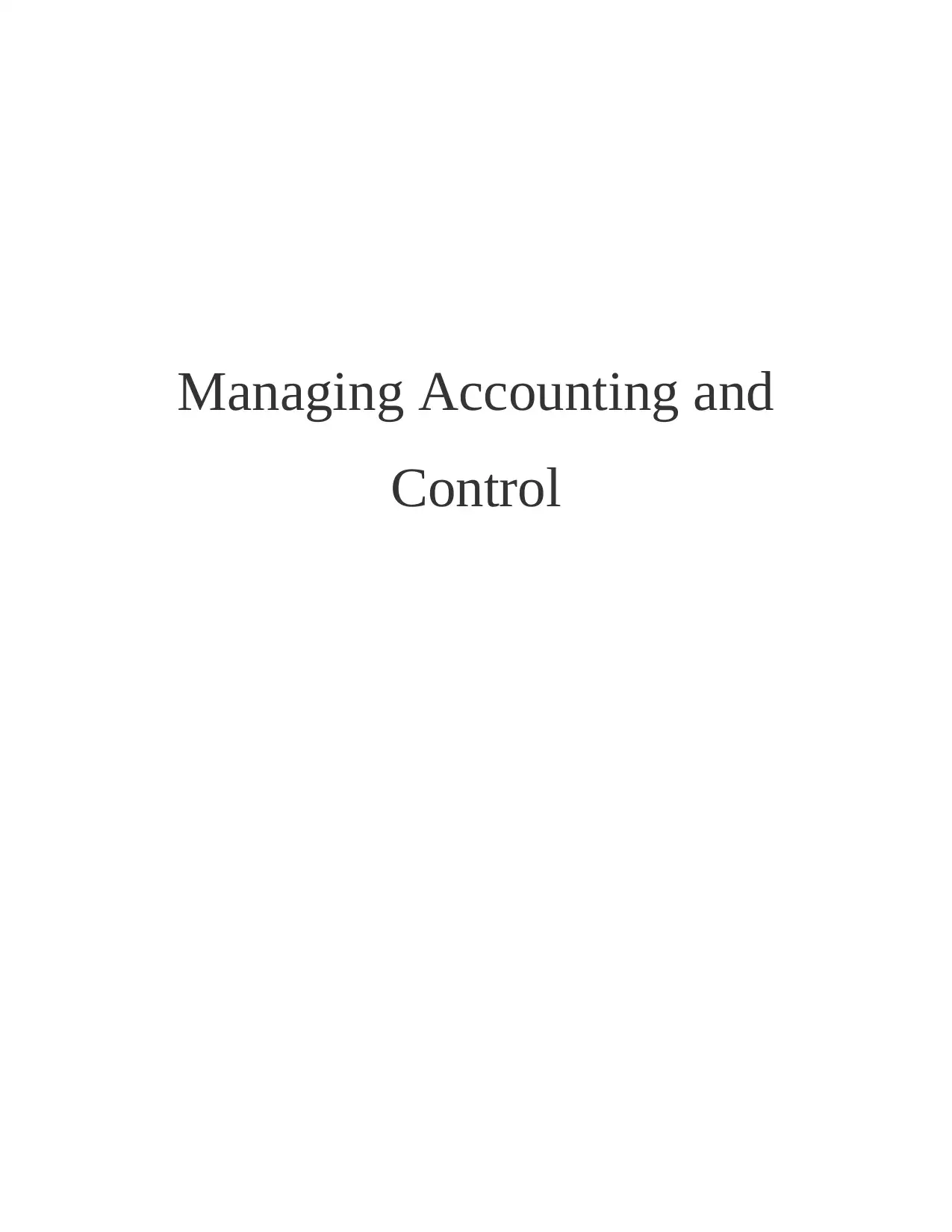
Managing Accounting and
Control
Control
Paraphrase This Document
Need a fresh take? Get an instant paraphrase of this document with our AI Paraphraser
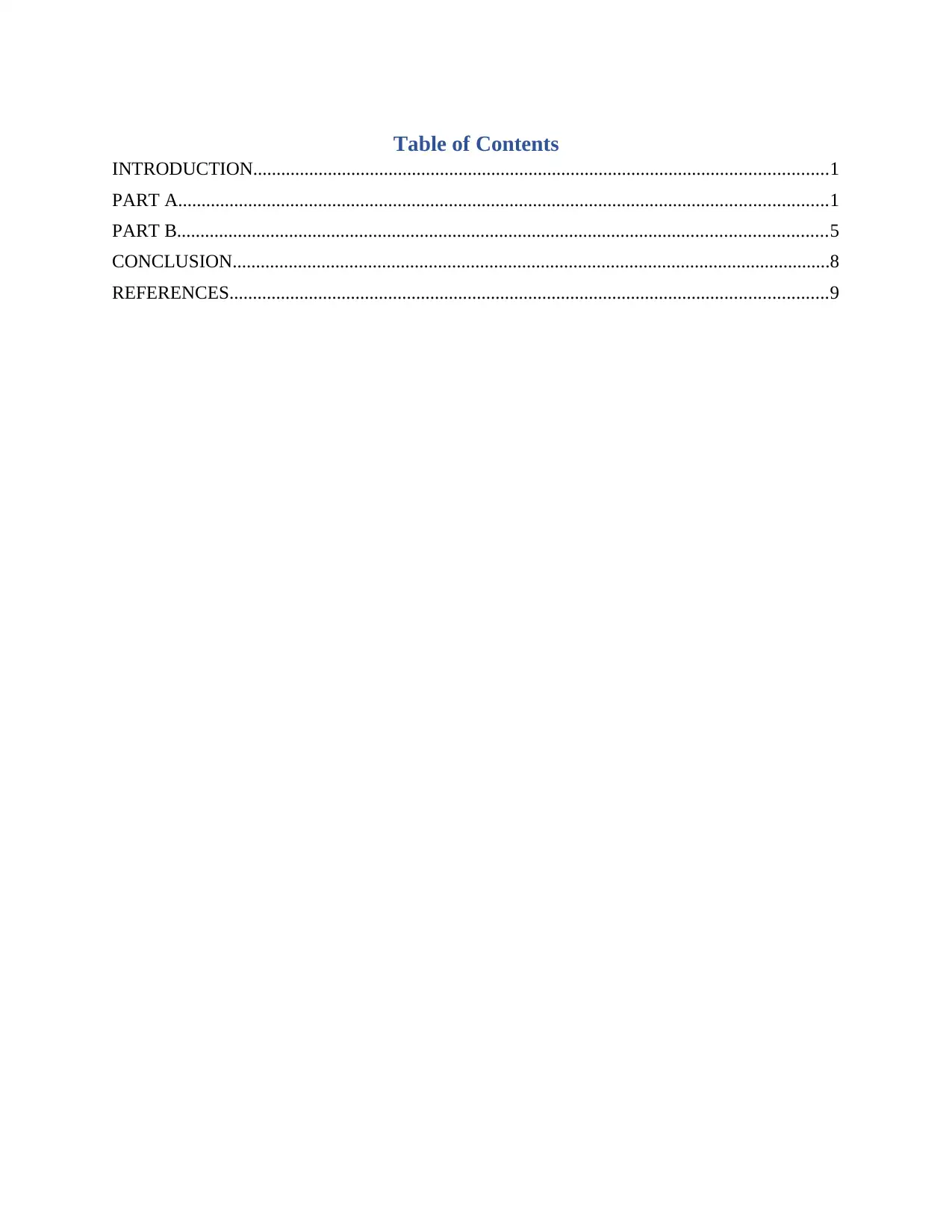
Table of Contents
INTRODUCTION...........................................................................................................................1
PART A...........................................................................................................................................1
PART B...........................................................................................................................................5
CONCLUSION................................................................................................................................8
REFERENCES................................................................................................................................9
INTRODUCTION...........................................................................................................................1
PART A...........................................................................................................................................1
PART B...........................................................................................................................................5
CONCLUSION................................................................................................................................8
REFERENCES................................................................................................................................9
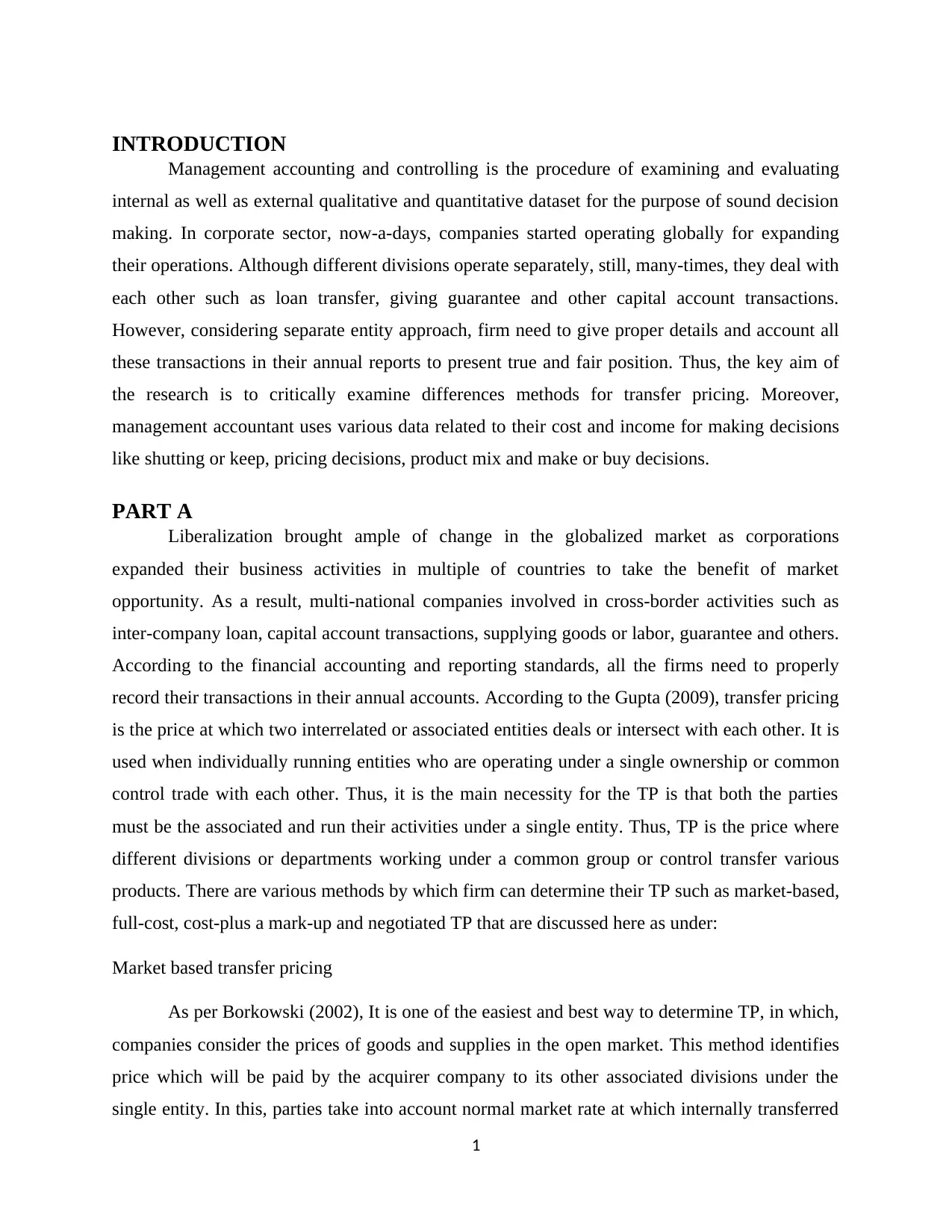
INTRODUCTION
Management accounting and controlling is the procedure of examining and evaluating
internal as well as external qualitative and quantitative dataset for the purpose of sound decision
making. In corporate sector, now-a-days, companies started operating globally for expanding
their operations. Although different divisions operate separately, still, many-times, they deal with
each other such as loan transfer, giving guarantee and other capital account transactions.
However, considering separate entity approach, firm need to give proper details and account all
these transactions in their annual reports to present true and fair position. Thus, the key aim of
the research is to critically examine differences methods for transfer pricing. Moreover,
management accountant uses various data related to their cost and income for making decisions
like shutting or keep, pricing decisions, product mix and make or buy decisions.
PART A
Liberalization brought ample of change in the globalized market as corporations
expanded their business activities in multiple of countries to take the benefit of market
opportunity. As a result, multi-national companies involved in cross-border activities such as
inter-company loan, capital account transactions, supplying goods or labor, guarantee and others.
According to the financial accounting and reporting standards, all the firms need to properly
record their transactions in their annual accounts. According to the Gupta (2009), transfer pricing
is the price at which two interrelated or associated entities deals or intersect with each other. It is
used when individually running entities who are operating under a single ownership or common
control trade with each other. Thus, it is the main necessity for the TP is that both the parties
must be the associated and run their activities under a single entity. Thus, TP is the price where
different divisions or departments working under a common group or control transfer various
products. There are various methods by which firm can determine their TP such as market-based,
full-cost, cost-plus a mark-up and negotiated TP that are discussed here as under:
Market based transfer pricing
As per Borkowski (2002), It is one of the easiest and best way to determine TP, in which,
companies consider the prices of goods and supplies in the open market. This method identifies
price which will be paid by the acquirer company to its other associated divisions under the
single entity. In this, parties take into account normal market rate at which internally transferred
1
Management accounting and controlling is the procedure of examining and evaluating
internal as well as external qualitative and quantitative dataset for the purpose of sound decision
making. In corporate sector, now-a-days, companies started operating globally for expanding
their operations. Although different divisions operate separately, still, many-times, they deal with
each other such as loan transfer, giving guarantee and other capital account transactions.
However, considering separate entity approach, firm need to give proper details and account all
these transactions in their annual reports to present true and fair position. Thus, the key aim of
the research is to critically examine differences methods for transfer pricing. Moreover,
management accountant uses various data related to their cost and income for making decisions
like shutting or keep, pricing decisions, product mix and make or buy decisions.
PART A
Liberalization brought ample of change in the globalized market as corporations
expanded their business activities in multiple of countries to take the benefit of market
opportunity. As a result, multi-national companies involved in cross-border activities such as
inter-company loan, capital account transactions, supplying goods or labor, guarantee and others.
According to the financial accounting and reporting standards, all the firms need to properly
record their transactions in their annual accounts. According to the Gupta (2009), transfer pricing
is the price at which two interrelated or associated entities deals or intersect with each other. It is
used when individually running entities who are operating under a single ownership or common
control trade with each other. Thus, it is the main necessity for the TP is that both the parties
must be the associated and run their activities under a single entity. Thus, TP is the price where
different divisions or departments working under a common group or control transfer various
products. There are various methods by which firm can determine their TP such as market-based,
full-cost, cost-plus a mark-up and negotiated TP that are discussed here as under:
Market based transfer pricing
As per Borkowski (2002), It is one of the easiest and best way to determine TP, in which,
companies consider the prices of goods and supplies in the open market. This method identifies
price which will be paid by the acquirer company to its other associated divisions under the
single entity. In this, parties take into account normal market rate at which internally transferred
1
⊘ This is a preview!⊘
Do you want full access?
Subscribe today to unlock all pages.

Trusted by 1+ million students worldwide
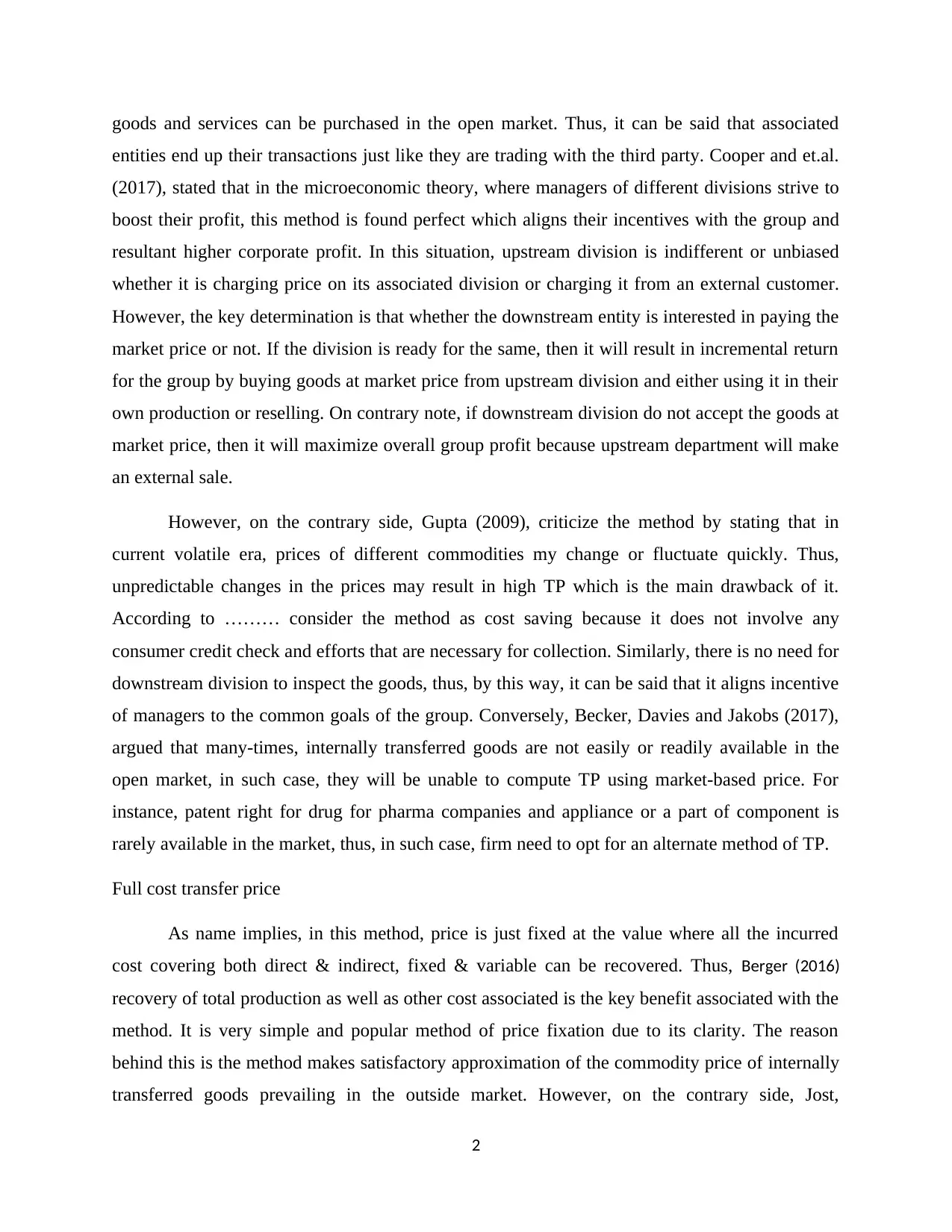
goods and services can be purchased in the open market. Thus, it can be said that associated
entities end up their transactions just like they are trading with the third party. Cooper and et.al.
(2017), stated that in the microeconomic theory, where managers of different divisions strive to
boost their profit, this method is found perfect which aligns their incentives with the group and
resultant higher corporate profit. In this situation, upstream division is indifferent or unbiased
whether it is charging price on its associated division or charging it from an external customer.
However, the key determination is that whether the downstream entity is interested in paying the
market price or not. If the division is ready for the same, then it will result in incremental return
for the group by buying goods at market price from upstream division and either using it in their
own production or reselling. On contrary note, if downstream division do not accept the goods at
market price, then it will maximize overall group profit because upstream department will make
an external sale.
However, on the contrary side, Gupta (2009), criticize the method by stating that in
current volatile era, prices of different commodities my change or fluctuate quickly. Thus,
unpredictable changes in the prices may result in high TP which is the main drawback of it.
According to ……… consider the method as cost saving because it does not involve any
consumer credit check and efforts that are necessary for collection. Similarly, there is no need for
downstream division to inspect the goods, thus, by this way, it can be said that it aligns incentive
of managers to the common goals of the group. Conversely, Becker, Davies and Jakobs (2017),
argued that many-times, internally transferred goods are not easily or readily available in the
open market, in such case, they will be unable to compute TP using market-based price. For
instance, patent right for drug for pharma companies and appliance or a part of component is
rarely available in the market, thus, in such case, firm need to opt for an alternate method of TP.
Full cost transfer price
As name implies, in this method, price is just fixed at the value where all the incurred
cost covering both direct & indirect, fixed & variable can be recovered. Thus, Berger (2016)
recovery of total production as well as other cost associated is the key benefit associated with the
method. It is very simple and popular method of price fixation due to its clarity. The reason
behind this is the method makes satisfactory approximation of the commodity price of internally
transferred goods prevailing in the outside market. However, on the contrary side, Jost,
2
entities end up their transactions just like they are trading with the third party. Cooper and et.al.
(2017), stated that in the microeconomic theory, where managers of different divisions strive to
boost their profit, this method is found perfect which aligns their incentives with the group and
resultant higher corporate profit. In this situation, upstream division is indifferent or unbiased
whether it is charging price on its associated division or charging it from an external customer.
However, the key determination is that whether the downstream entity is interested in paying the
market price or not. If the division is ready for the same, then it will result in incremental return
for the group by buying goods at market price from upstream division and either using it in their
own production or reselling. On contrary note, if downstream division do not accept the goods at
market price, then it will maximize overall group profit because upstream department will make
an external sale.
However, on the contrary side, Gupta (2009), criticize the method by stating that in
current volatile era, prices of different commodities my change or fluctuate quickly. Thus,
unpredictable changes in the prices may result in high TP which is the main drawback of it.
According to ……… consider the method as cost saving because it does not involve any
consumer credit check and efforts that are necessary for collection. Similarly, there is no need for
downstream division to inspect the goods, thus, by this way, it can be said that it aligns incentive
of managers to the common goals of the group. Conversely, Becker, Davies and Jakobs (2017),
argued that many-times, internally transferred goods are not easily or readily available in the
open market, in such case, they will be unable to compute TP using market-based price. For
instance, patent right for drug for pharma companies and appliance or a part of component is
rarely available in the market, thus, in such case, firm need to opt for an alternate method of TP.
Full cost transfer price
As name implies, in this method, price is just fixed at the value where all the incurred
cost covering both direct & indirect, fixed & variable can be recovered. Thus, Berger (2016)
recovery of total production as well as other cost associated is the key benefit associated with the
method. It is very simple and popular method of price fixation due to its clarity. The reason
behind this is the method makes satisfactory approximation of the commodity price of internally
transferred goods prevailing in the outside market. However, on the contrary side, Jost,
2
Paraphrase This Document
Need a fresh take? Get an instant paraphrase of this document with our AI Paraphraser
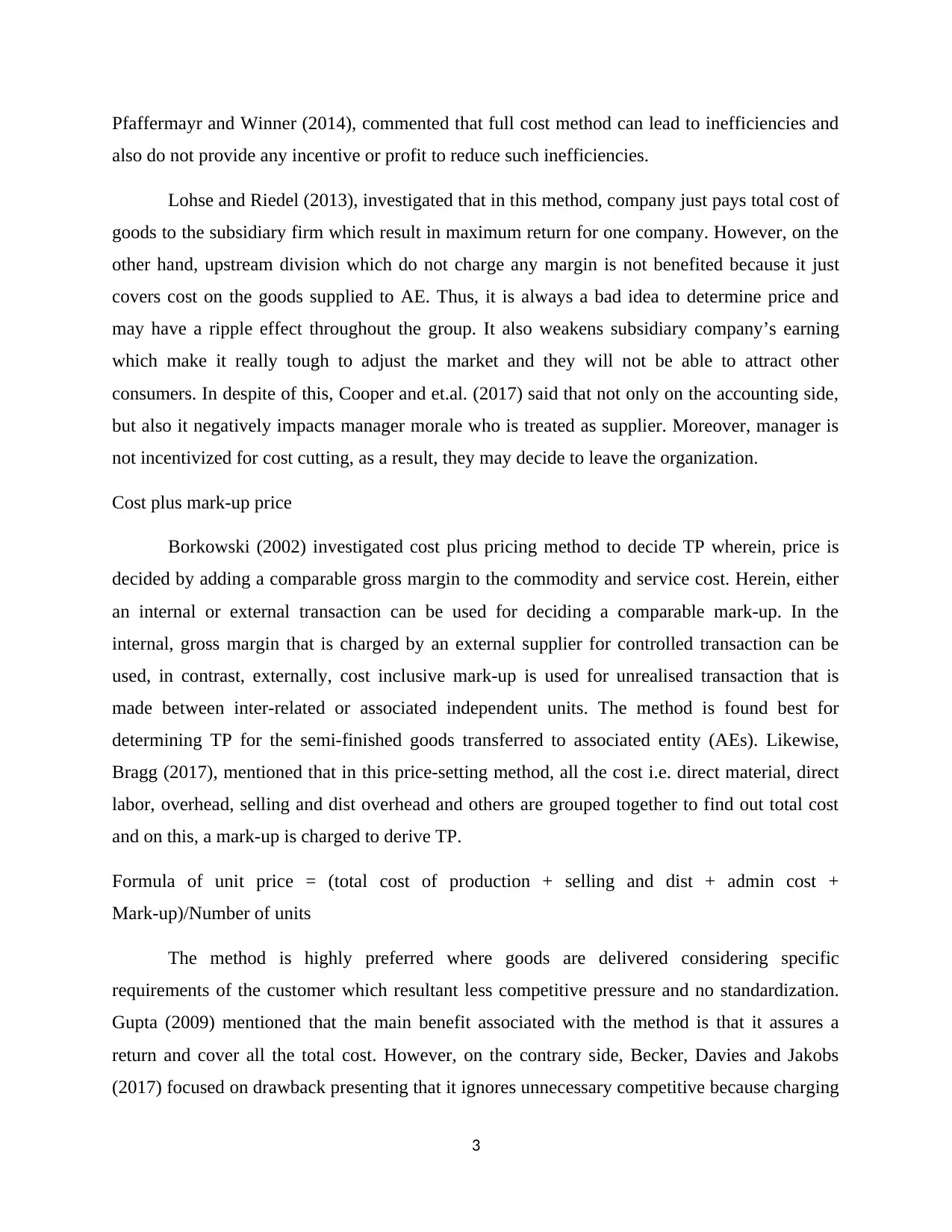
Pfaffermayr and Winner (2014), commented that full cost method can lead to inefficiencies and
also do not provide any incentive or profit to reduce such inefficiencies.
Lohse and Riedel (2013), investigated that in this method, company just pays total cost of
goods to the subsidiary firm which result in maximum return for one company. However, on the
other hand, upstream division which do not charge any margin is not benefited because it just
covers cost on the goods supplied to AE. Thus, it is always a bad idea to determine price and
may have a ripple effect throughout the group. It also weakens subsidiary company’s earning
which make it really tough to adjust the market and they will not be able to attract other
consumers. In despite of this, Cooper and et.al. (2017) said that not only on the accounting side,
but also it negatively impacts manager morale who is treated as supplier. Moreover, manager is
not incentivized for cost cutting, as a result, they may decide to leave the organization.
Cost plus mark-up price
Borkowski (2002) investigated cost plus pricing method to decide TP wherein, price is
decided by adding a comparable gross margin to the commodity and service cost. Herein, either
an internal or external transaction can be used for deciding a comparable mark-up. In the
internal, gross margin that is charged by an external supplier for controlled transaction can be
used, in contrast, externally, cost inclusive mark-up is used for unrealised transaction that is
made between inter-related or associated independent units. The method is found best for
determining TP for the semi-finished goods transferred to associated entity (AEs). Likewise,
Bragg (2017), mentioned that in this price-setting method, all the cost i.e. direct material, direct
labor, overhead, selling and dist overhead and others are grouped together to find out total cost
and on this, a mark-up is charged to derive TP.
Formula of unit price = (total cost of production + selling and dist + admin cost +
Mark-up)/Number of units
The method is highly preferred where goods are delivered considering specific
requirements of the customer which resultant less competitive pressure and no standardization.
Gupta (2009) mentioned that the main benefit associated with the method is that it assures a
return and cover all the total cost. However, on the contrary side, Becker, Davies and Jakobs
(2017) focused on drawback presenting that it ignores unnecessary competitive because charging
3
also do not provide any incentive or profit to reduce such inefficiencies.
Lohse and Riedel (2013), investigated that in this method, company just pays total cost of
goods to the subsidiary firm which result in maximum return for one company. However, on the
other hand, upstream division which do not charge any margin is not benefited because it just
covers cost on the goods supplied to AE. Thus, it is always a bad idea to determine price and
may have a ripple effect throughout the group. It also weakens subsidiary company’s earning
which make it really tough to adjust the market and they will not be able to attract other
consumers. In despite of this, Cooper and et.al. (2017) said that not only on the accounting side,
but also it negatively impacts manager morale who is treated as supplier. Moreover, manager is
not incentivized for cost cutting, as a result, they may decide to leave the organization.
Cost plus mark-up price
Borkowski (2002) investigated cost plus pricing method to decide TP wherein, price is
decided by adding a comparable gross margin to the commodity and service cost. Herein, either
an internal or external transaction can be used for deciding a comparable mark-up. In the
internal, gross margin that is charged by an external supplier for controlled transaction can be
used, in contrast, externally, cost inclusive mark-up is used for unrealised transaction that is
made between inter-related or associated independent units. The method is found best for
determining TP for the semi-finished goods transferred to associated entity (AEs). Likewise,
Bragg (2017), mentioned that in this price-setting method, all the cost i.e. direct material, direct
labor, overhead, selling and dist overhead and others are grouped together to find out total cost
and on this, a mark-up is charged to derive TP.
Formula of unit price = (total cost of production + selling and dist + admin cost +
Mark-up)/Number of units
The method is highly preferred where goods are delivered considering specific
requirements of the customer which resultant less competitive pressure and no standardization.
Gupta (2009) mentioned that the main benefit associated with the method is that it assures a
return and cover all the total cost. However, on the contrary side, Becker, Davies and Jakobs
(2017) focused on drawback presenting that it ignores unnecessary competitive because charging
3
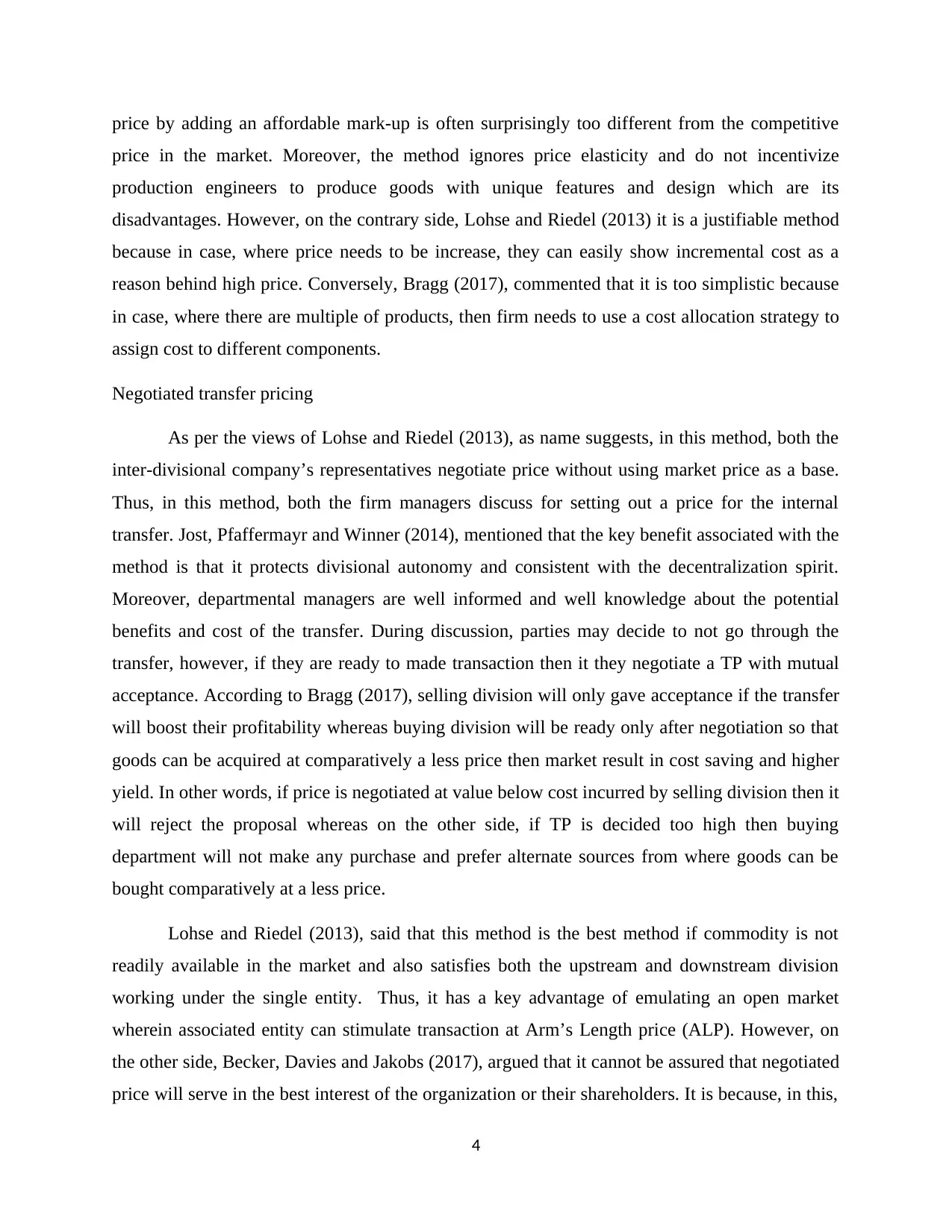
price by adding an affordable mark-up is often surprisingly too different from the competitive
price in the market. Moreover, the method ignores price elasticity and do not incentivize
production engineers to produce goods with unique features and design which are its
disadvantages. However, on the contrary side, Lohse and Riedel (2013) it is a justifiable method
because in case, where price needs to be increase, they can easily show incremental cost as a
reason behind high price. Conversely, Bragg (2017), commented that it is too simplistic because
in case, where there are multiple of products, then firm needs to use a cost allocation strategy to
assign cost to different components.
Negotiated transfer pricing
As per the views of Lohse and Riedel (2013), as name suggests, in this method, both the
inter-divisional company’s representatives negotiate price without using market price as a base.
Thus, in this method, both the firm managers discuss for setting out a price for the internal
transfer. Jost, Pfaffermayr and Winner (2014), mentioned that the key benefit associated with the
method is that it protects divisional autonomy and consistent with the decentralization spirit.
Moreover, departmental managers are well informed and well knowledge about the potential
benefits and cost of the transfer. During discussion, parties may decide to not go through the
transfer, however, if they are ready to made transaction then it they negotiate a TP with mutual
acceptance. According to Bragg (2017), selling division will only gave acceptance if the transfer
will boost their profitability whereas buying division will be ready only after negotiation so that
goods can be acquired at comparatively a less price then market result in cost saving and higher
yield. In other words, if price is negotiated at value below cost incurred by selling division then it
will reject the proposal whereas on the other side, if TP is decided too high then buying
department will not make any purchase and prefer alternate sources from where goods can be
bought comparatively at a less price.
Lohse and Riedel (2013), said that this method is the best method if commodity is not
readily available in the market and also satisfies both the upstream and downstream division
working under the single entity. Thus, it has a key advantage of emulating an open market
wherein associated entity can stimulate transaction at Arm’s Length price (ALP). However, on
the other side, Becker, Davies and Jakobs (2017), argued that it cannot be assured that negotiated
price will serve in the best interest of the organization or their shareholders. It is because, in this,
4
price in the market. Moreover, the method ignores price elasticity and do not incentivize
production engineers to produce goods with unique features and design which are its
disadvantages. However, on the contrary side, Lohse and Riedel (2013) it is a justifiable method
because in case, where price needs to be increase, they can easily show incremental cost as a
reason behind high price. Conversely, Bragg (2017), commented that it is too simplistic because
in case, where there are multiple of products, then firm needs to use a cost allocation strategy to
assign cost to different components.
Negotiated transfer pricing
As per the views of Lohse and Riedel (2013), as name suggests, in this method, both the
inter-divisional company’s representatives negotiate price without using market price as a base.
Thus, in this method, both the firm managers discuss for setting out a price for the internal
transfer. Jost, Pfaffermayr and Winner (2014), mentioned that the key benefit associated with the
method is that it protects divisional autonomy and consistent with the decentralization spirit.
Moreover, departmental managers are well informed and well knowledge about the potential
benefits and cost of the transfer. During discussion, parties may decide to not go through the
transfer, however, if they are ready to made transaction then it they negotiate a TP with mutual
acceptance. According to Bragg (2017), selling division will only gave acceptance if the transfer
will boost their profitability whereas buying division will be ready only after negotiation so that
goods can be acquired at comparatively a less price then market result in cost saving and higher
yield. In other words, if price is negotiated at value below cost incurred by selling division then it
will reject the proposal whereas on the other side, if TP is decided too high then buying
department will not make any purchase and prefer alternate sources from where goods can be
bought comparatively at a less price.
Lohse and Riedel (2013), said that this method is the best method if commodity is not
readily available in the market and also satisfies both the upstream and downstream division
working under the single entity. Thus, it has a key advantage of emulating an open market
wherein associated entity can stimulate transaction at Arm’s Length price (ALP). However, on
the other side, Becker, Davies and Jakobs (2017), argued that it cannot be assured that negotiated
price will serve in the best interest of the organization or their shareholders. It is because, in this,
4
⊘ This is a preview!⊘
Do you want full access?
Subscribe today to unlock all pages.

Trusted by 1+ million students worldwide
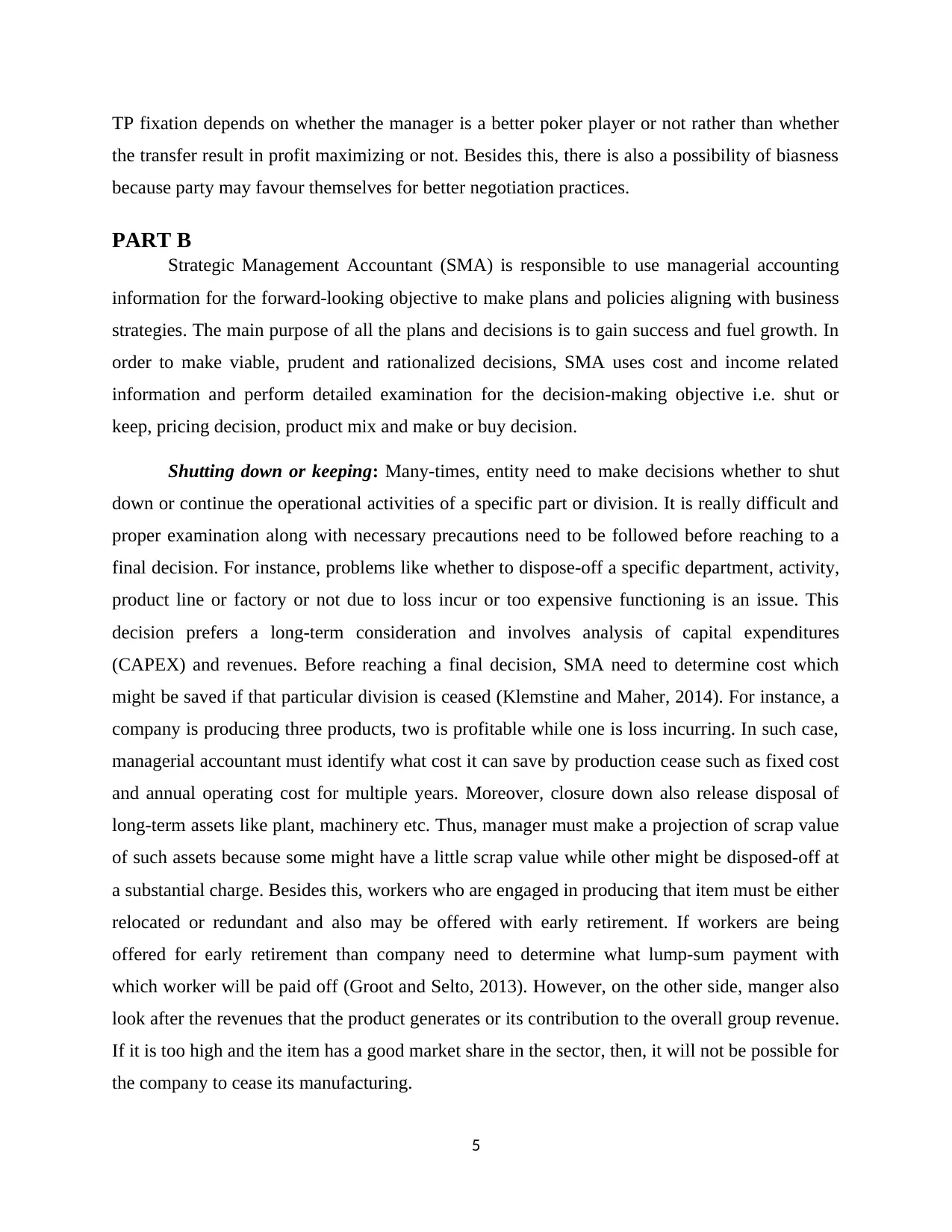
TP fixation depends on whether the manager is a better poker player or not rather than whether
the transfer result in profit maximizing or not. Besides this, there is also a possibility of biasness
because party may favour themselves for better negotiation practices.
PART B
Strategic Management Accountant (SMA) is responsible to use managerial accounting
information for the forward-looking objective to make plans and policies aligning with business
strategies. The main purpose of all the plans and decisions is to gain success and fuel growth. In
order to make viable, prudent and rationalized decisions, SMA uses cost and income related
information and perform detailed examination for the decision-making objective i.e. shut or
keep, pricing decision, product mix and make or buy decision.
Shutting down or keeping: Many-times, entity need to make decisions whether to shut
down or continue the operational activities of a specific part or division. It is really difficult and
proper examination along with necessary precautions need to be followed before reaching to a
final decision. For instance, problems like whether to dispose-off a specific department, activity,
product line or factory or not due to loss incur or too expensive functioning is an issue. This
decision prefers a long-term consideration and involves analysis of capital expenditures
(CAPEX) and revenues. Before reaching a final decision, SMA need to determine cost which
might be saved if that particular division is ceased (Klemstine and Maher, 2014). For instance, a
company is producing three products, two is profitable while one is loss incurring. In such case,
managerial accountant must identify what cost it can save by production cease such as fixed cost
and annual operating cost for multiple years. Moreover, closure down also release disposal of
long-term assets like plant, machinery etc. Thus, manager must make a projection of scrap value
of such assets because some might have a little scrap value while other might be disposed-off at
a substantial charge. Besides this, workers who are engaged in producing that item must be either
relocated or redundant and also may be offered with early retirement. If workers are being
offered for early retirement than company need to determine what lump-sum payment with
which worker will be paid off (Groot and Selto, 2013). However, on the other side, manger also
look after the revenues that the product generates or its contribution to the overall group revenue.
If it is too high and the item has a good market share in the sector, then, it will not be possible for
the company to cease its manufacturing.
5
the transfer result in profit maximizing or not. Besides this, there is also a possibility of biasness
because party may favour themselves for better negotiation practices.
PART B
Strategic Management Accountant (SMA) is responsible to use managerial accounting
information for the forward-looking objective to make plans and policies aligning with business
strategies. The main purpose of all the plans and decisions is to gain success and fuel growth. In
order to make viable, prudent and rationalized decisions, SMA uses cost and income related
information and perform detailed examination for the decision-making objective i.e. shut or
keep, pricing decision, product mix and make or buy decision.
Shutting down or keeping: Many-times, entity need to make decisions whether to shut
down or continue the operational activities of a specific part or division. It is really difficult and
proper examination along with necessary precautions need to be followed before reaching to a
final decision. For instance, problems like whether to dispose-off a specific department, activity,
product line or factory or not due to loss incur or too expensive functioning is an issue. This
decision prefers a long-term consideration and involves analysis of capital expenditures
(CAPEX) and revenues. Before reaching a final decision, SMA need to determine cost which
might be saved if that particular division is ceased (Klemstine and Maher, 2014). For instance, a
company is producing three products, two is profitable while one is loss incurring. In such case,
managerial accountant must identify what cost it can save by production cease such as fixed cost
and annual operating cost for multiple years. Moreover, closure down also release disposal of
long-term assets like plant, machinery etc. Thus, manager must make a projection of scrap value
of such assets because some might have a little scrap value while other might be disposed-off at
a substantial charge. Besides this, workers who are engaged in producing that item must be either
relocated or redundant and also may be offered with early retirement. If workers are being
offered for early retirement than company need to determine what lump-sum payment with
which worker will be paid off (Groot and Selto, 2013). However, on the other side, manger also
look after the revenues that the product generates or its contribution to the overall group revenue.
If it is too high and the item has a good market share in the sector, then, it will not be possible for
the company to cease its manufacturing.
5
Paraphrase This Document
Need a fresh take? Get an instant paraphrase of this document with our AI Paraphraser
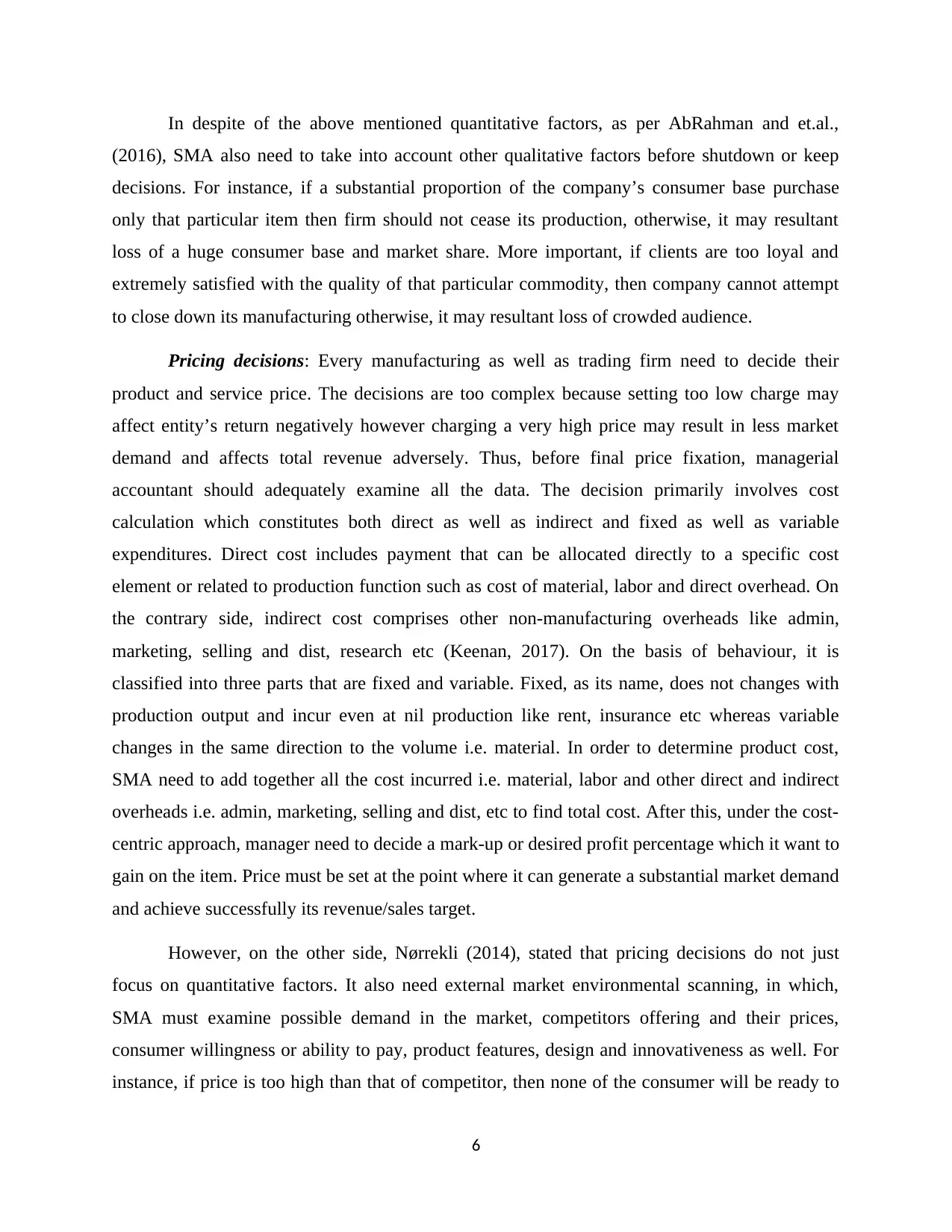
In despite of the above mentioned quantitative factors, as per AbRahman and et.al.,
(2016), SMA also need to take into account other qualitative factors before shutdown or keep
decisions. For instance, if a substantial proportion of the company’s consumer base purchase
only that particular item then firm should not cease its production, otherwise, it may resultant
loss of a huge consumer base and market share. More important, if clients are too loyal and
extremely satisfied with the quality of that particular commodity, then company cannot attempt
to close down its manufacturing otherwise, it may resultant loss of crowded audience.
Pricing decisions: Every manufacturing as well as trading firm need to decide their
product and service price. The decisions are too complex because setting too low charge may
affect entity’s return negatively however charging a very high price may result in less market
demand and affects total revenue adversely. Thus, before final price fixation, managerial
accountant should adequately examine all the data. The decision primarily involves cost
calculation which constitutes both direct as well as indirect and fixed as well as variable
expenditures. Direct cost includes payment that can be allocated directly to a specific cost
element or related to production function such as cost of material, labor and direct overhead. On
the contrary side, indirect cost comprises other non-manufacturing overheads like admin,
marketing, selling and dist, research etc (Keenan, 2017). On the basis of behaviour, it is
classified into three parts that are fixed and variable. Fixed, as its name, does not changes with
production output and incur even at nil production like rent, insurance etc whereas variable
changes in the same direction to the volume i.e. material. In order to determine product cost,
SMA need to add together all the cost incurred i.e. material, labor and other direct and indirect
overheads i.e. admin, marketing, selling and dist, etc to find total cost. After this, under the cost-
centric approach, manager need to decide a mark-up or desired profit percentage which it want to
gain on the item. Price must be set at the point where it can generate a substantial market demand
and achieve successfully its revenue/sales target.
However, on the other side, Nørrekli (2014), stated that pricing decisions do not just
focus on quantitative factors. It also need external market environmental scanning, in which,
SMA must examine possible demand in the market, competitors offering and their prices,
consumer willingness or ability to pay, product features, design and innovativeness as well. For
instance, if price is too high than that of competitor, then none of the consumer will be ready to
6
(2016), SMA also need to take into account other qualitative factors before shutdown or keep
decisions. For instance, if a substantial proportion of the company’s consumer base purchase
only that particular item then firm should not cease its production, otherwise, it may resultant
loss of a huge consumer base and market share. More important, if clients are too loyal and
extremely satisfied with the quality of that particular commodity, then company cannot attempt
to close down its manufacturing otherwise, it may resultant loss of crowded audience.
Pricing decisions: Every manufacturing as well as trading firm need to decide their
product and service price. The decisions are too complex because setting too low charge may
affect entity’s return negatively however charging a very high price may result in less market
demand and affects total revenue adversely. Thus, before final price fixation, managerial
accountant should adequately examine all the data. The decision primarily involves cost
calculation which constitutes both direct as well as indirect and fixed as well as variable
expenditures. Direct cost includes payment that can be allocated directly to a specific cost
element or related to production function such as cost of material, labor and direct overhead. On
the contrary side, indirect cost comprises other non-manufacturing overheads like admin,
marketing, selling and dist, research etc (Keenan, 2017). On the basis of behaviour, it is
classified into three parts that are fixed and variable. Fixed, as its name, does not changes with
production output and incur even at nil production like rent, insurance etc whereas variable
changes in the same direction to the volume i.e. material. In order to determine product cost,
SMA need to add together all the cost incurred i.e. material, labor and other direct and indirect
overheads i.e. admin, marketing, selling and dist, etc to find total cost. After this, under the cost-
centric approach, manager need to decide a mark-up or desired profit percentage which it want to
gain on the item. Price must be set at the point where it can generate a substantial market demand
and achieve successfully its revenue/sales target.
However, on the other side, Nørrekli (2014), stated that pricing decisions do not just
focus on quantitative factors. It also need external market environmental scanning, in which,
SMA must examine possible demand in the market, competitors offering and their prices,
consumer willingness or ability to pay, product features, design and innovativeness as well. For
instance, if price is too high than that of competitor, then none of the consumer will be ready to
6
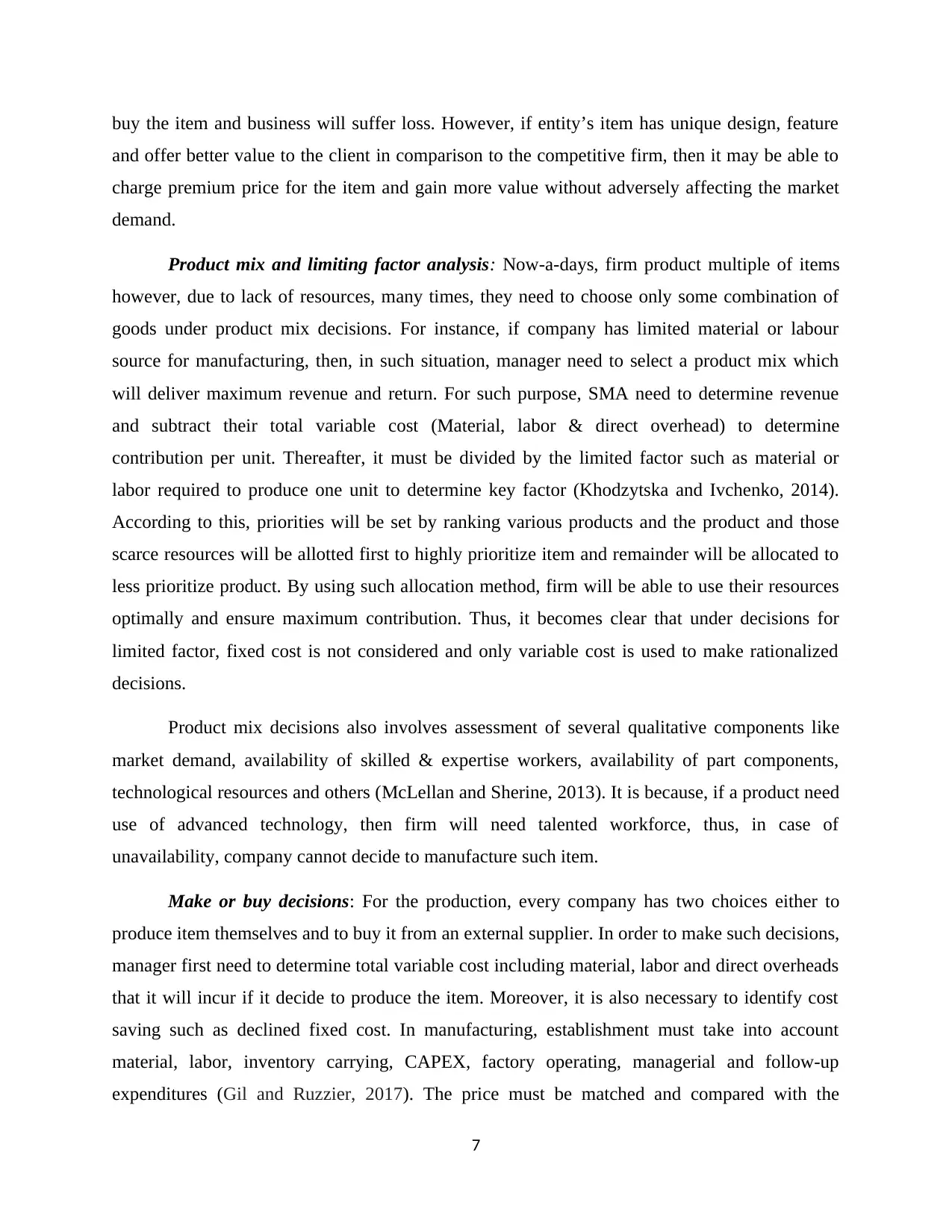
buy the item and business will suffer loss. However, if entity’s item has unique design, feature
and offer better value to the client in comparison to the competitive firm, then it may be able to
charge premium price for the item and gain more value without adversely affecting the market
demand.
Product mix and limiting factor analysis: Now-a-days, firm product multiple of items
however, due to lack of resources, many times, they need to choose only some combination of
goods under product mix decisions. For instance, if company has limited material or labour
source for manufacturing, then, in such situation, manager need to select a product mix which
will deliver maximum revenue and return. For such purpose, SMA need to determine revenue
and subtract their total variable cost (Material, labor & direct overhead) to determine
contribution per unit. Thereafter, it must be divided by the limited factor such as material or
labor required to produce one unit to determine key factor (Khodzytska and Ivchenko, 2014).
According to this, priorities will be set by ranking various products and the product and those
scarce resources will be allotted first to highly prioritize item and remainder will be allocated to
less prioritize product. By using such allocation method, firm will be able to use their resources
optimally and ensure maximum contribution. Thus, it becomes clear that under decisions for
limited factor, fixed cost is not considered and only variable cost is used to make rationalized
decisions.
Product mix decisions also involves assessment of several qualitative components like
market demand, availability of skilled & expertise workers, availability of part components,
technological resources and others (McLellan and Sherine, 2013). It is because, if a product need
use of advanced technology, then firm will need talented workforce, thus, in case of
unavailability, company cannot decide to manufacture such item.
Make or buy decisions: For the production, every company has two choices either to
produce item themselves and to buy it from an external supplier. In order to make such decisions,
manager first need to determine total variable cost including material, labor and direct overheads
that it will incur if it decide to produce the item. Moreover, it is also necessary to identify cost
saving such as declined fixed cost. In manufacturing, establishment must take into account
material, labor, inventory carrying, CAPEX, factory operating, managerial and follow-up
expenditures (Gil and Ruzzier, 2017). The price must be matched and compared with the
7
and offer better value to the client in comparison to the competitive firm, then it may be able to
charge premium price for the item and gain more value without adversely affecting the market
demand.
Product mix and limiting factor analysis: Now-a-days, firm product multiple of items
however, due to lack of resources, many times, they need to choose only some combination of
goods under product mix decisions. For instance, if company has limited material or labour
source for manufacturing, then, in such situation, manager need to select a product mix which
will deliver maximum revenue and return. For such purpose, SMA need to determine revenue
and subtract their total variable cost (Material, labor & direct overhead) to determine
contribution per unit. Thereafter, it must be divided by the limited factor such as material or
labor required to produce one unit to determine key factor (Khodzytska and Ivchenko, 2014).
According to this, priorities will be set by ranking various products and the product and those
scarce resources will be allotted first to highly prioritize item and remainder will be allocated to
less prioritize product. By using such allocation method, firm will be able to use their resources
optimally and ensure maximum contribution. Thus, it becomes clear that under decisions for
limited factor, fixed cost is not considered and only variable cost is used to make rationalized
decisions.
Product mix decisions also involves assessment of several qualitative components like
market demand, availability of skilled & expertise workers, availability of part components,
technological resources and others (McLellan and Sherine, 2013). It is because, if a product need
use of advanced technology, then firm will need talented workforce, thus, in case of
unavailability, company cannot decide to manufacture such item.
Make or buy decisions: For the production, every company has two choices either to
produce item themselves and to buy it from an external supplier. In order to make such decisions,
manager first need to determine total variable cost including material, labor and direct overheads
that it will incur if it decide to produce the item. Moreover, it is also necessary to identify cost
saving such as declined fixed cost. In manufacturing, establishment must take into account
material, labor, inventory carrying, CAPEX, factory operating, managerial and follow-up
expenditures (Gil and Ruzzier, 2017). The price must be matched and compared with the
7
⊘ This is a preview!⊘
Do you want full access?
Subscribe today to unlock all pages.

Trusted by 1+ million students worldwide
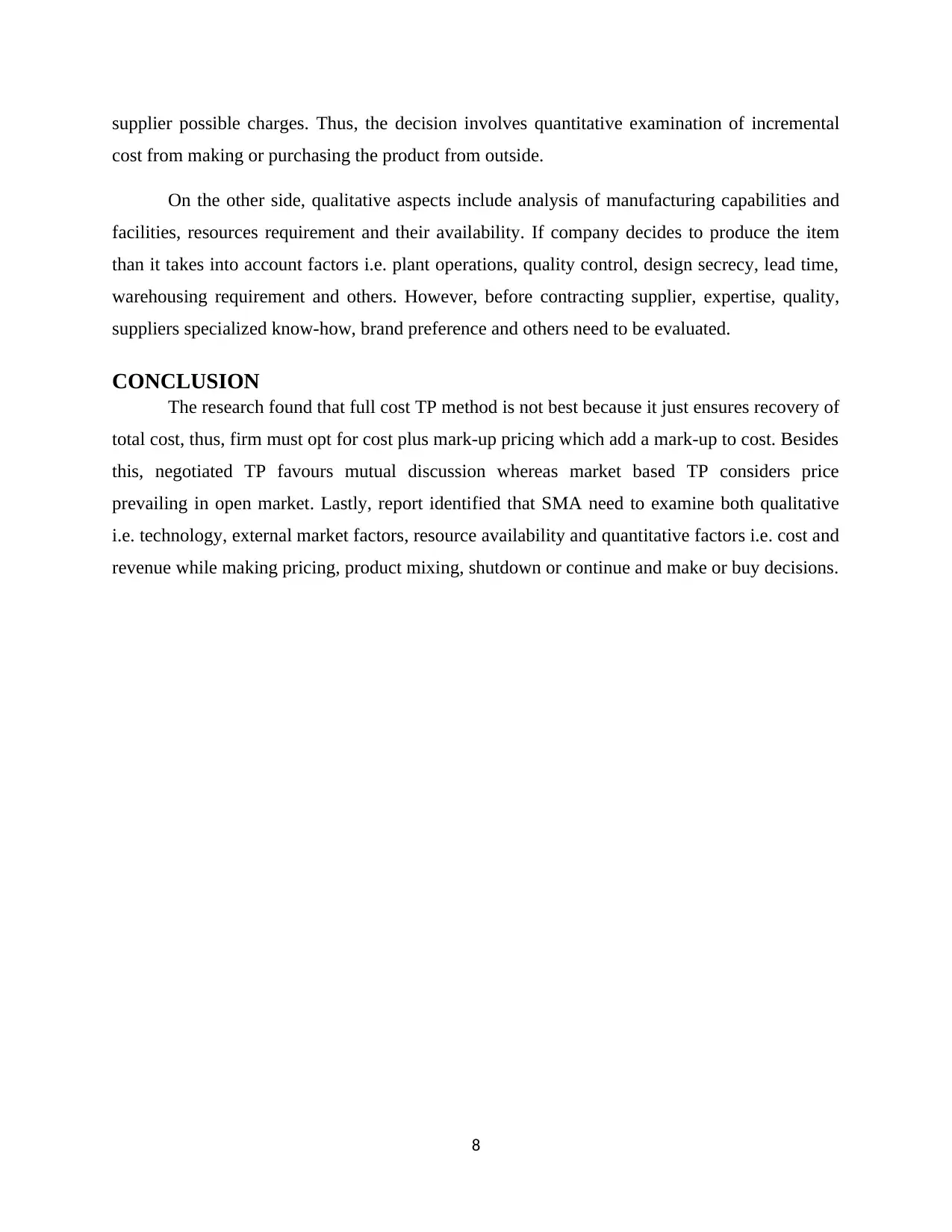
supplier possible charges. Thus, the decision involves quantitative examination of incremental
cost from making or purchasing the product from outside.
On the other side, qualitative aspects include analysis of manufacturing capabilities and
facilities, resources requirement and their availability. If company decides to produce the item
than it takes into account factors i.e. plant operations, quality control, design secrecy, lead time,
warehousing requirement and others. However, before contracting supplier, expertise, quality,
suppliers specialized know-how, brand preference and others need to be evaluated.
CONCLUSION
The research found that full cost TP method is not best because it just ensures recovery of
total cost, thus, firm must opt for cost plus mark-up pricing which add a mark-up to cost. Besides
this, negotiated TP favours mutual discussion whereas market based TP considers price
prevailing in open market. Lastly, report identified that SMA need to examine both qualitative
i.e. technology, external market factors, resource availability and quantitative factors i.e. cost and
revenue while making pricing, product mixing, shutdown or continue and make or buy decisions.
8
cost from making or purchasing the product from outside.
On the other side, qualitative aspects include analysis of manufacturing capabilities and
facilities, resources requirement and their availability. If company decides to produce the item
than it takes into account factors i.e. plant operations, quality control, design secrecy, lead time,
warehousing requirement and others. However, before contracting supplier, expertise, quality,
suppliers specialized know-how, brand preference and others need to be evaluated.
CONCLUSION
The research found that full cost TP method is not best because it just ensures recovery of
total cost, thus, firm must opt for cost plus mark-up pricing which add a mark-up to cost. Besides
this, negotiated TP favours mutual discussion whereas market based TP considers price
prevailing in open market. Lastly, report identified that SMA need to examine both qualitative
i.e. technology, external market factors, resource availability and quantitative factors i.e. cost and
revenue while making pricing, product mixing, shutdown or continue and make or buy decisions.
8
Paraphrase This Document
Need a fresh take? Get an instant paraphrase of this document with our AI Paraphraser
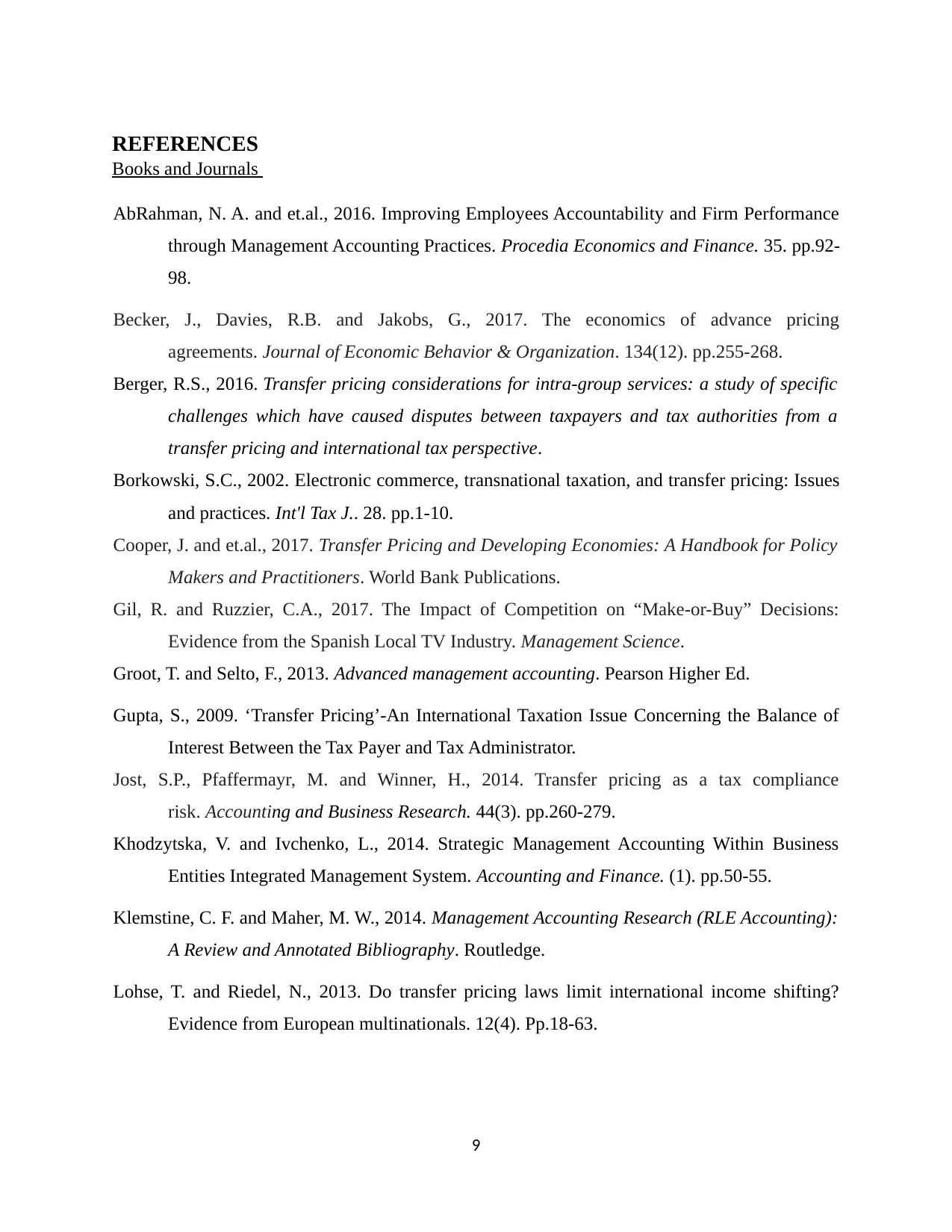
REFERENCES
Books and Journals
AbRahman, N. A. and et.al., 2016. Improving Employees Accountability and Firm Performance
through Management Accounting Practices. Procedia Economics and Finance. 35. pp.92-
98.
Becker, J., Davies, R.B. and Jakobs, G., 2017. The economics of advance pricing
agreements. Journal of Economic Behavior & Organization. 134(12). pp.255-268.
Berger, R.S., 2016. Transfer pricing considerations for intra-group services: a study of specific
challenges which have caused disputes between taxpayers and tax authorities from a
transfer pricing and international tax perspective.
Borkowski, S.C., 2002. Electronic commerce, transnational taxation, and transfer pricing: Issues
and practices. Int'l Tax J.. 28. pp.1-10.
Cooper, J. and et.al., 2017. Transfer Pricing and Developing Economies: A Handbook for Policy
Makers and Practitioners. World Bank Publications.
Gil, R. and Ruzzier, C.A., 2017. The Impact of Competition on “Make-or-Buy” Decisions:
Evidence from the Spanish Local TV Industry. Management Science.
Groot, T. and Selto, F., 2013. Advanced management accounting. Pearson Higher Ed.
Gupta, S., 2009. ‘Transfer Pricing’-An International Taxation Issue Concerning the Balance of
Interest Between the Tax Payer and Tax Administrator.
Jost, S.P., Pfaffermayr, M. and Winner, H., 2014. Transfer pricing as a tax compliance
risk. Accounting and Business Research. 44(3). pp.260-279.
Khodzytska, V. and Ivchenko, L., 2014. Strategic Management Accounting Within Business
Entities Integrated Management System. Accounting and Finance. (1). pp.50-55.
Klemstine, C. F. and Maher, M. W., 2014. Management Accounting Research (RLE Accounting):
A Review and Annotated Bibliography. Routledge.
Lohse, T. and Riedel, N., 2013. Do transfer pricing laws limit international income shifting?
Evidence from European multinationals. 12(4). Pp.18-63.
9
Books and Journals
AbRahman, N. A. and et.al., 2016. Improving Employees Accountability and Firm Performance
through Management Accounting Practices. Procedia Economics and Finance. 35. pp.92-
98.
Becker, J., Davies, R.B. and Jakobs, G., 2017. The economics of advance pricing
agreements. Journal of Economic Behavior & Organization. 134(12). pp.255-268.
Berger, R.S., 2016. Transfer pricing considerations for intra-group services: a study of specific
challenges which have caused disputes between taxpayers and tax authorities from a
transfer pricing and international tax perspective.
Borkowski, S.C., 2002. Electronic commerce, transnational taxation, and transfer pricing: Issues
and practices. Int'l Tax J.. 28. pp.1-10.
Cooper, J. and et.al., 2017. Transfer Pricing and Developing Economies: A Handbook for Policy
Makers and Practitioners. World Bank Publications.
Gil, R. and Ruzzier, C.A., 2017. The Impact of Competition on “Make-or-Buy” Decisions:
Evidence from the Spanish Local TV Industry. Management Science.
Groot, T. and Selto, F., 2013. Advanced management accounting. Pearson Higher Ed.
Gupta, S., 2009. ‘Transfer Pricing’-An International Taxation Issue Concerning the Balance of
Interest Between the Tax Payer and Tax Administrator.
Jost, S.P., Pfaffermayr, M. and Winner, H., 2014. Transfer pricing as a tax compliance
risk. Accounting and Business Research. 44(3). pp.260-279.
Khodzytska, V. and Ivchenko, L., 2014. Strategic Management Accounting Within Business
Entities Integrated Management System. Accounting and Finance. (1). pp.50-55.
Klemstine, C. F. and Maher, M. W., 2014. Management Accounting Research (RLE Accounting):
A Review and Annotated Bibliography. Routledge.
Lohse, T. and Riedel, N., 2013. Do transfer pricing laws limit international income shifting?
Evidence from European multinationals. 12(4). Pp.18-63.
9
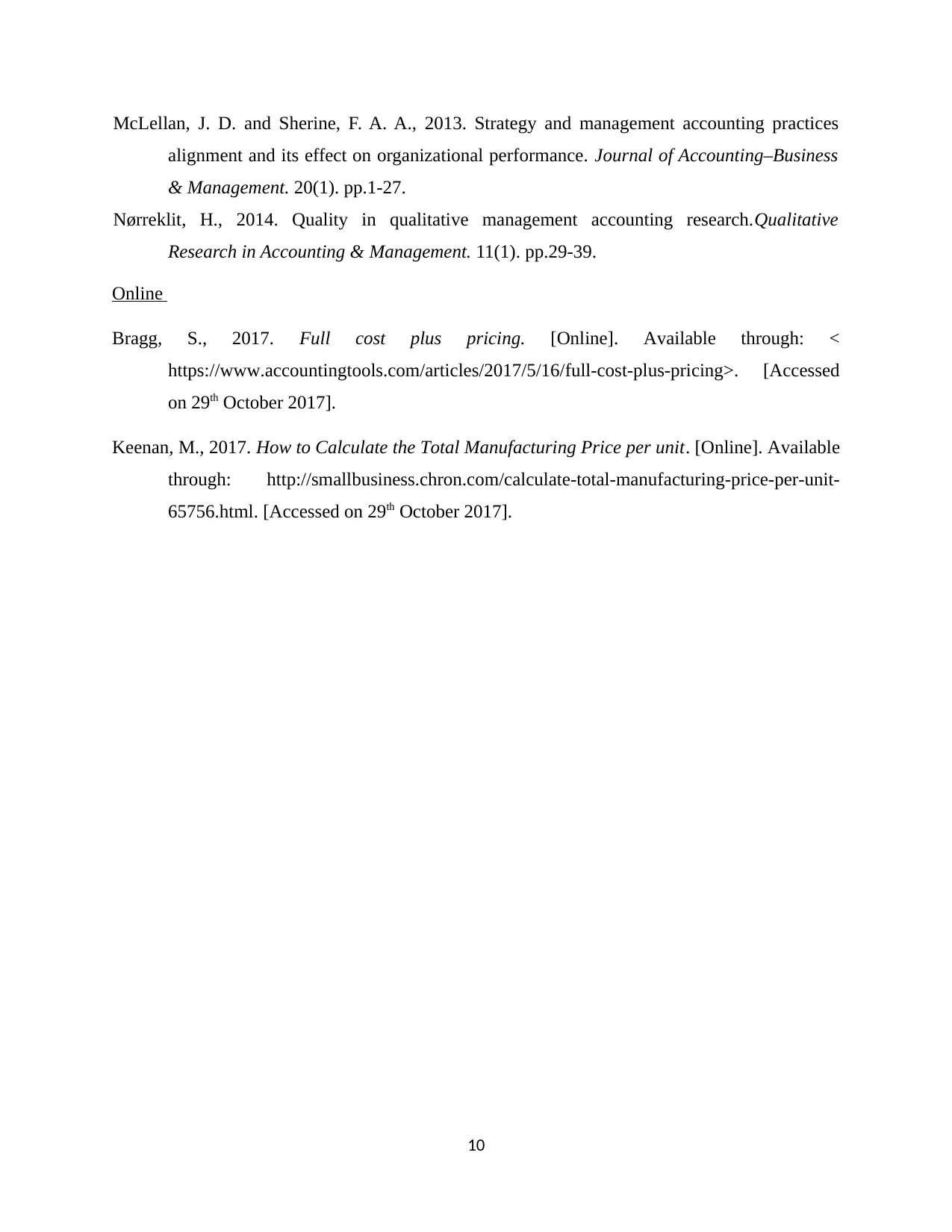
McLellan, J. D. and Sherine, F. A. A., 2013. Strategy and management accounting practices
alignment and its effect on organizational performance. Journal of Accounting–Business
& Management. 20(1). pp.1-27.
Nørreklit, H., 2014. Quality in qualitative management accounting research.Qualitative
Research in Accounting & Management. 11(1). pp.29-39.
Online
Bragg, S., 2017. Full cost plus pricing. [Online]. Available through: <
https://www.accountingtools.com/articles/2017/5/16/full-cost-plus-pricing>. [Accessed
on 29th October 2017].
Keenan, M., 2017. How to Calculate the Total Manufacturing Price per unit. [Online]. Available
through: http://smallbusiness.chron.com/calculate-total-manufacturing-price-per-unit-
65756.html. [Accessed on 29th October 2017].
10
alignment and its effect on organizational performance. Journal of Accounting–Business
& Management. 20(1). pp.1-27.
Nørreklit, H., 2014. Quality in qualitative management accounting research.Qualitative
Research in Accounting & Management. 11(1). pp.29-39.
Online
Bragg, S., 2017. Full cost plus pricing. [Online]. Available through: <
https://www.accountingtools.com/articles/2017/5/16/full-cost-plus-pricing>. [Accessed
on 29th October 2017].
Keenan, M., 2017. How to Calculate the Total Manufacturing Price per unit. [Online]. Available
through: http://smallbusiness.chron.com/calculate-total-manufacturing-price-per-unit-
65756.html. [Accessed on 29th October 2017].
10
⊘ This is a preview!⊘
Do you want full access?
Subscribe today to unlock all pages.

Trusted by 1+ million students worldwide
1 out of 12
Related Documents
Your All-in-One AI-Powered Toolkit for Academic Success.
+13062052269
info@desklib.com
Available 24*7 on WhatsApp / Email
![[object Object]](/_next/static/media/star-bottom.7253800d.svg)
Unlock your academic potential
Copyright © 2020–2025 A2Z Services. All Rights Reserved. Developed and managed by ZUCOL.





